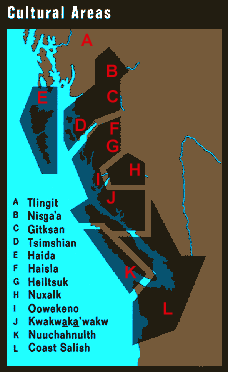Grand Hall tour
Peoples of the Coast
 The Native people of the Pacific Coast live on the islands, bays, and
fjords of the sheltered waterway that runs along the west coast of
Canada and southeast Alaska. Ancestral territories of coastal peoples
also stretch inland along the rivers into the Coast Mountains.
The Native people of the Pacific Coast live on the islands, bays, and
fjords of the sheltered waterway that runs along the west coast of
Canada and southeast Alaska. Ancestral territories of coastal peoples
also stretch inland along the rivers into the Coast Mountains.
The Pacific Coast is abundant in the resources that formed the basis of the traditional economy -- salmon and eulachon in the rivers; herring, halibut, cod, seals, sea lions and whales in the open sea; seaweed and shellfish along the shore and on the rocks left visible by the receding tide; and, in the forests, berries, lupine roots, hemlock bark, and last, but extremely important, cedar, hemlock and yew.
When European explorers arrived in the 1770s, there were at least fifteen languages spoken on the coast, belonging to five distinct language families. Every region had its own languages, traditions, and distinctive identity. Although some dialects are no longer spoken, attempts are being made to record and learn surviving languages before they disappear.
The arrival of explorers, followed by fur traders, missionaries, the British Navy, and settlers, brought tragedy, opportunity and dilemmas to every family on the coast. The last years of the eighteenth century represent a period of innovation, change, resistance loss, recovery, and ultimately, survival.
